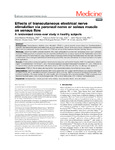Effects of transcutaneous electrical nerve stimulation via peroneal nerve or soleus muscle on venous Ffow: a randomized cross-over study in healthy subjects

Use este enlace para citar
http://hdl.handle.net/2183/21110
Excepto si se señala otra cosa, la licencia del ítem se describe como Creative Commons Attribution-NonCommercial 4.0 International Licence (CC-BY-NC 4.0)
Colecciones
- Investigación (FFISIO) [481]
Metadatos
Mostrar el registro completo del ítemTítulo
Effects of transcutaneous electrical nerve stimulation via peroneal nerve or soleus muscle on venous Ffow: a randomized cross-over study in healthy subjectsAutor(es)
Fecha
2018Cita bibliográfica
Martínez-Rodríguez A, Senín-Camargo F, Raposo-Vidal I, Chouza-Insua M, Rodríguez-Romero B, Amalia JM. Effects of transcutaneous electrical nerve stimulation via peroneal nerve or soleus muscle on venous flow: a randomized cross-over study in healthy subjects. Medicine (Baltimore). 2018;97(36):e12084
Resumen
[Abstract] Background: Transcutaneous electrical nerve stimulation (TENS) is used to prevent venous stasis and thromboembolism. However, best electrostimulation parameters have yet to be established. The aim of the study was to compare the hemodynamic effects and the participants’ relative discomfort of 3 TENS sequences at the maximum tolerated intensity stimulus.
Methods: Twenty-four healthy university students (50% male) participated in a cross-over, randomized study. Each participant received 2 TENS sequences on peroneal nerve at 1 and 5 Hz, and the third one on soleus muscle at 5 Hz. Popliteal flow volume (FV) and peak velocity (PV) were measured using Doppler ultrasound and the relative change from basal values was recorded. Discomfort questionnaires -visual analogue scale (VAS) and verbal rating scale (VRS)- were also administered to compare sensations among the three applications.
Results: All interventions produced significant hemodynamic responses compared to baseline. Both 5 Hz applications obtained higher FV increments than 1 Hz TENS (P < .001). The muscle application resulted in the lowest PV increment (P < .001). TENS at 5 Hz on nerve location was the worst tolerated, with higher values in VRS (P = .056) and VAS (P = .11), although not significant.
Conclusion: TENS at 5 Hz on soleus site may be the most appropriate protocol for enhancing venous return.
Palabras clave
Hemodynamics
Muscle
Peroneal nerve
Skeletal
Transcutaneous electric nerve stimulation
Muscle
Peroneal nerve
Skeletal
Transcutaneous electric nerve stimulation
Versión del editor
Derechos
Creative Commons Attribution-NonCommercial 4.0 International Licence (CC-BY-NC 4.0)
ISSN
0025-7974






